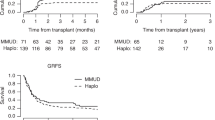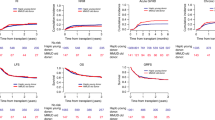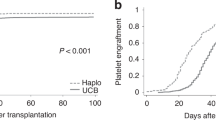Abstract
The optimal alternative donor for relapsed/refractory acute lymphoblastic leukemia (R/R ALL) patients remains controversial. We retrospectively analyzed adult R/R ALL patients who underwent a first allogeneic hematopoietic cell transplantation (allo-HCT) between 2010 and 2022 from either a haploidentical donor (Haplo-HCT) or a 10/10 matched unrelated donor (MUD-HCT). The analysis comprised 249 patients (80 Haplo-HCT and 169 MUD-HCT). For graft-versus-host disease (GVHD) prophylaxis, all Haplo-HCT recipients received post-transplant cyclophosphamide (PTCy)-based regimen, whereas all MUD-HCT recipients received anti-thymocyte globulin (ATG) only. After propensity score matching, 47 Haplo-HCT and 69 MUD-HCT recipients were enrolled. No significant differences were observed in the incidence of Day 180 grade II–IV aGVHD (34.4% vs. 26.8%; P = 0.27), or 2-year cGVHD (19.2% vs. 13.8%; P = 0.543). However, the incidence of Day 180 grade III–IV aGVHD was significantly higher in the Haplo-HCT group (23.4% vs. 8%; P = 0.048). Two-year overall survival (31.8% vs. 29.2%; P = 0.742), leukemia-free survival (20.4% vs. 24.4%; P = 0.531), relapse incidence (48.1% vs. 53.1%; P = 0.113), or non-relapse mortality (31.5% vs. 22.5%; P = 0.191) were comparable between Haplo-HCT group and MUD-HCT group, respectively. In conclusion, despite a higher incidence of grade III–IV aGVHD, outcomes for R/R ALL patients receiving Haplo-HCT with PTCy were comparable to those receiving 10/10 MUD-HCT with ATG.
This is a preview of subscription content, access via your institution
Access options
Subscribe to this journal
Receive 12 print issues and online access
$259.00 per year
only $21.58 per issue
Buy this article
- Purchase on SpringerLink
- Instant access to full article PDF
Prices may be subject to local taxes which are calculated during checkout


Similar content being viewed by others
Data availability
The datasets generated during and/or analyzed during the current study are available from the corresponding author upon reasonable request. The study was presented at the 51st annual meeting of the EBMT, Florence, Italy, April 2025.
References
DeFilipp Z, Advani AS, Bachanova V, Cassaday RD, Deangelo DJ, Kebriaei P, et al. Hematopoietic cell transplantation in the treatment of adult acute lymphoblastic leukemia: updated 2019 evidence-based review from the American Society for Transplantation and Cellular Therapy. Biol Blood Marrow Transpl. 2019;25:2113–23. https://doi.org/10.1016/j.bbmt.2019.08.014.
Pavlů J, Labopin M, Zoellner AK, Sakellari I, Stelljes M, Finke J, et al. Allogeneic hematopoietic cell transplantation for primary refractory acute lymphoblastic leukemia: a report from the Acute Leukemia Working Party of the EBMT. Cancer. 2017;123:1965–70. https://doi.org/10.1002/cncr.30604.
Nagler A, Labopin M, Dholaria B, Finke J, Brecht A, Schanz U, et al. Second allogeneic stem cell transplantation in patients with acute lymphoblastic leukaemia: a study on behalf of the Acute Leukaemia Working Party of the European Society for Blood and Marrow Transplantation. Br J Haematol. 2019;186:767–76. https://doi.org/10.1111/bjh.15973.
Bazarbachi AH, Al Hamed R, Labopin M, Afanasyev B, Hamladji RM, Beelen D, et al. Allogeneic stem-cell transplantation with sequential conditioning in adult patients with refractory or relapsed acute lymphoblastic leukemia: a report from the EBMT Acute Leukemia Working Party. Bone Marrow Transpl. 2020;55:595–602. https://doi.org/10.1038/s41409-019-0702-2.
Gragert L, Eapen M, Williams E, Freeman J, Spellman S, Baitty R, et al. HLA match likelihoods for hematopoietic stem-cell grafts in the U.S. registry. N Engl J Med. 2014;371:339–48. https://doi.org/10.1056/NEJMsa1311707.
Passweg JR, Baldomero H, Bader P, Bonini C, Duarte RF, Dufour C, et al. Use of haploidentical stem cell transplantation continues to increase: the 2015 European Society for Blood and Marrow Transplant activity survey report. Bone Marrow Transpl. 2017;52:811–7. https://doi.org/10.1038/bmt.2017.34.
Wieduwilt MJ, Metheny L, Zhang MJ, Wang HL, Estrada-Merly N, Marks DI, et al. Haploidentical vs sibling, unrelated, or cord blood hematopoietic cell transplantation for acute lymphoblastic leukemia. Blood Adv. 2022;6:339–57. https://doi.org/10.1182/bloodadvances.2021004916.
Shem-Tov N, Peczynski C, Labopin M, Itälä-Remes M, Blaise D, Labussière-Wallet H, et al. Haploidentical vs. unrelated allogeneic stem cell transplantation for acute lymphoblastic leukemia in first complete remission: on behalf of the ALWP of the EBMT. Leukemia. 2020;34:283–92. https://doi.org/10.1038/s41375-019-0544-3.
Nagler A, Labopin M, Houhou M, Aljurf M, Mousavi A, Hamladji RM, et al. Outcome of haploidentical versus matched sibling donors in hematopoietic stem cell transplantation for adult patients with acute lymphoblastic leukemia: a study from the Acute Leukemia Working Party of the European Society for Blood and Marrow Transplantation. J Hematol Oncol. 2021;14:53. https://doi.org/10.1186/s13045-021-01065-7.
Sanz J, Galimard JE, Labopin M, Afanasyev B, Sergeevich MI, Angelucci E, et al. Post-transplant cyclophosphamide containing regimens after matched sibling, matched unrelated and haploidentical donor transplants in patients with acute lymphoblastic leukemia in first complete remission, a comparative study of the ALWP of the EBMT. J Hematol Oncol. 2021;14:84. https://doi.org/10.1186/s13045-021-01094-2.
Nagler A, Labopin M, Swoboda R, Pioltelli P, Arat M, Yakoub-Agha I, et al. Haploidentical versus matched sibling donor hematopoietic stem cell transplantation for adult patients with relapsed/refractory acute lymphoblastic leukemia: a study from the Acute Leukemia Working Party of the European Society for Blood and Marrow Transplantation. Hemasphere. 2022;6:e790 https://doi.org/10.1097/hs9.0000000000000790.
Nagler A, Kanate AS, Labopin M, Ciceri F, Angelucci E, Koc Y, et al. Post-transplant cyclophosphamide versus anti-thymocyte globulin for graft-versus-host disease prevention in haploidentical transplantation for adult acute lymphoblastic leukemia. Haematologica. 2021;106:1591–8. https://doi.org/10.3324/haematol.2020.247296.
Chang YJ, Wang Y, Xu LP, Zhang XH, Chen H, Chen YH, et al. Haploidentical donor is preferred over matched sibling donor for pre-transplantation MRD positive ALL: a phase 3 genetically randomized study. J Hematol Oncol. 2020;13:27. https://doi.org/10.1186/s13045-020-00860-y.
Duval M, Klein JP, He W, Cahn JY, Cairo M, Camitta BM, et al. Hematopoietic stem-cell transplantation for acute leukemia in relapse or primary induction failure. J Clin Oncol. 2010;28:3730–8. https://doi.org/10.1200/jco.2010.28.8852.
Oriol A, Vives S, Hernández-Rivas JM, Tormo M, Heras I, Rivas C, et al. Outcome after relapse of acute lymphoblastic leukemia in adult patients included in four consecutive risk-adapted trials by the PETHEMA Study Group. Haematologica. 2010;95:589–96. https://doi.org/10.3324/haematol.2009.014274.
O’Brien S, Thomas D, Ravandi F, Faderl S, Cortes J, Borthakur G, et al. Outcome of adults with acute lymphocytic leukemia after second salvage therapy. Cancer. 2008;113:3186–91. https://doi.org/10.1002/cncr.23919.
Shouval R, Fein JA, Labopin M, Kröger N, Duarte RF, Bader P, et al. Outcomes of allogeneic haematopoietic stem cell transplantation from HLA-matched and alternative donors: a European Society for Blood and Marrow Transplantation registry retrospective analysis. Lancet Haematol. 2019;6:e573–84. https://doi.org/10.1016/s2352-3026(19)30158-9.
Passweg JR, Baldomero H, Chabannon C, Basak GW, Corbacioglu S, Duarte R, et al. The EBMT activity survey on hematopoietic-cell transplantation and cellular therapy 2018: CAR-T’s come into focus. Bone Marrow Transpl. 2020;55:1604–13. https://doi.org/10.1038/s41409-020-0826-4.
Ruggeri A, Labopin M, Bacigalupo A, Afanasyev B, Cornelissen JJ, Elmaagacli A, et al. Post-transplant cyclophosphamide for graft-versus-host disease prophylaxis in HLA matched sibling or matched unrelated donor transplant for patients with acute leukemia, on behalf of ALWP-EBMT. J Hematol Oncol. 2018;11:40. https://doi.org/10.1186/s13045-018-0586-4.
Kanakry CG, Tsai HL, Bolaños-Meade J, Smith BD, Gojo I, Kanakry JA, et al. Single-agent GVHD prophylaxis with posttransplantation cyclophosphamide after myeloablative, HLA-matched BMT for AML, ALL, and MDS. Blood. 2014;124:3817–27. https://doi.org/10.1182/blood-2014-07-587477.
Luznik L, Bolaños-Meade J, Zahurak M, Chen AR, Smith BD, Brodsky R, et al. High-dose cyclophosphamide as single-agent, short-course prophylaxis of graft-versus-host disease. Blood. 2010;115:3224–30. https://doi.org/10.1182/blood-2009-11-251595.
Luznik L, O’Donnell PV, Symons HJ, Chen AR, Leffell MS, Zahurak M, et al. HLA-haploidentical bone marrow transplantation for hematologic malignancies using nonmyeloablative conditioning and high-dose, posttransplantation cyclophosphamide. Biol Blood Marrow Transpl. 2008;14:641–50. https://doi.org/10.1016/j.bbmt.2008.03.005.
Webster JA, Reed M, Tsai HL, Ambinder A, Jain T, Dezern AE, et al. Allogeneic blood or marrow transplantation with high-dose post-transplantation cyclophosphamide for acute lymphoblastic leukemia in patients age ≥55 years. Transpl Cell Ther. 2023;29:182.e181–182.e188. https://doi.org/10.1016/j.jtct.2022.12.018.
McCurdy SR, Luznik L. How we perform haploidentical stem cell transplantation with posttransplant cyclophosphamide. Blood. 2019;134:1802–10. https://doi.org/10.1182/blood.2019001323.
Nakasone H, Fukuda T, Kanda J, Mori T, Yano S, Kobayashi T, et al. Impact of conditioning intensity and TBI on acute GVHD after hematopoietic cell transplantation. Bone Marrow Transplant. 2015;50:559–65. https://doi.org/10.1038/bmt.2014.293.
Kantarjian HM, DeAngelo DJ, Stelljes M, Liedtke M, Stock W, Gökbuget N, et al. Inotuzumab ozogamicin versus standard of care in relapsed or refractory acute lymphoblastic leukemia: final report and long-term survival follow-up from the randomized, phase 3 INO-VATE study. Cancer. 2019;125:2474–87. https://doi.org/10.1002/cncr.32116.
Kantarjian H, Stein A, Gökbuget N, Fielding AK, Schuh AC, Ribera JM, et al. Blinatumomab versus chemotherapy for advanced acute lymphoblastic leukemia. N Engl J Med. 2017;376:836–47. https://doi.org/10.1056/NEJMoa1609783.
Jiang H, Li C, Yin P, Guo T, Liu L, Xia L, et al. Anti-CD19 chimeric antigen receptor-modified T-cell therapy bridging to allogeneic hematopoietic stem cell transplantation for relapsed/refractory B-cell acute lymphoblastic leukemia: an open-label pragmatic clinical trial. Am J Hematol. 2019;94:1113–22. https://doi.org/10.1002/ajh.25582.
Zhao H, Wei J, Wei G, Luo Y, Shi J, Cui Q, et al. Pre-transplant MRD negativity predicts favorable outcomes of CAR-T therapy followed by haploidentical HSCT for relapsed/refractory acute lymphoblastic leukemia: a multi-center retrospective study. J Hematol Oncol. 2020;13:42 https://doi.org/10.1186/s13045-020-00873-7.
Zou J, Ciurea SO, Kongtim P, Yi M, Carmazzi Y, Rondon G, et al. Molecular disparity in human leukocyte antigens is associated with outcomes in haploidentical stem cell transplantation. Blood Adv. 2020;4:3474–85. https://doi.org/10.1182/bloodadvances.2019000797.
Arslan A, Labuhn S, Sala E, Ringhoffer M, Schetelig J, Schroeder T, et al. Outcomes of haploidentical transplants with PT-CY versus 10/10 MUD transplants with ATG in Germany. Blood Adv. 2024. https://doi.org/10.1182/bloodadvances.2024013719.
Brissot E, Labopin M, Ehninger G, Stelljes M, Brecht A, Ganser A, et al. Haploidentical versus unrelated allogeneic stem cell transplantation for relapsed/refractory acute myeloid leukemia: a report on 1578 patients from the Acute Leukemia Working Party of the EBMT. Haematologica. 2019;104:524–32. https://doi.org/10.3324/haematol.2017.187450.
Al Malki MM, Yang D, Labopin M, Afanasyev B, Angelucci E, Bashey A, et al. Comparing transplant outcomes in ALL patients after haploidentical with PTCy or matched unrelated donor transplantation. Blood Adv. 2020;4:2073–83. https://doi.org/10.1182/bloodadvances.2020001499.
Funding
The study was supported by the National Key R&D Program of China (2022YFC2502700); National Natural Science Foundation of China (82200237, 82370215).
Author information
Authors and Affiliations
Contributions
YR, JC, DW, and NCG designed the study. ATF performed the statistical analysis. HE, JT, IWB, EA, WB, RF, RZ, MM, and FC contributed data for the study. YR and JC wrote the manuscript. NCG revised the manuscript. All authors contributed to improving the initial manuscript and approved its final version.
Corresponding authors
Ethics declarations
Competing interests
The authors declare no competing interests.
Ethics approval and consent to participate
EBMT centers are committed to obtain informed consent according to the local regulations applicable at the time of transplantation in order to report data to the EBMT. The Global Committee and the ALWP of the EBMT approved this study, in accordance with the guidelines of the Declaration of Helsinki.
Additional information
Publisher’s note Springer Nature remains neutral with regard to jurisdictional claims in published maps and institutional affiliations.
Supplementary information
Rights and permissions
Springer Nature or its licensor (e.g. a society or other partner) holds exclusive rights to this article under a publishing agreement with the author(s) or other rightsholder(s); author self-archiving of the accepted manuscript version of this article is solely governed by the terms of such publishing agreement and applicable law.
About this article
Cite this article
Ru, Y., Chen, J., Ferhat, AT. et al. Haploidentical versus matched unrelated donor hematopoietic cell transplantation for adult patients with refractory/relapsed acute lymphoblastic leukemia: a study from the Global Committee and the Acute Leukemia Working Party of the European Society for Blood and Marrow Transplantation. Bone Marrow Transplant (2025). https://doi.org/10.1038/s41409-025-02708-w
Received:
Revised:
Accepted:
Published:
DOI: https://doi.org/10.1038/s41409-025-02708-w



